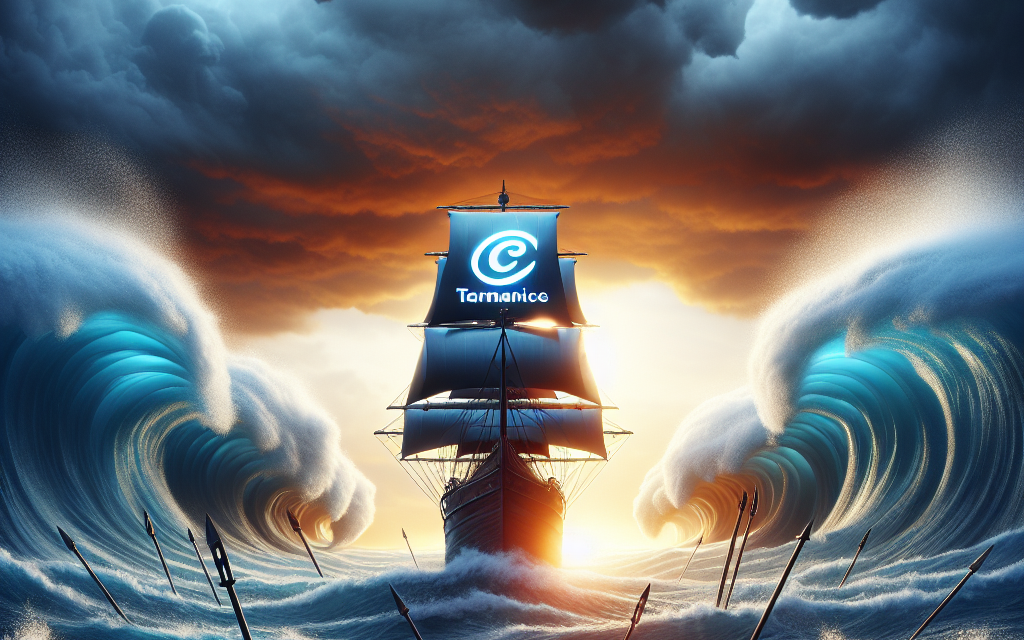“Intel Stock’s Crossroads: Will New Leadership Ignite a Turnaround?”
Introduction
Intel has faced significant challenges in recent years, marked by declining market share, production delays, and increased competition from rivals like AMD and NVIDIA. These struggles have led to a downturn in stock performance, raising concerns among investors about the company’s future prospects. With the appointment of a new CEO, there is renewed speculation about whether fresh leadership can revitalize Intel’s innovation pipeline, streamline operations, and restore investor confidence. As the semiconductor industry continues to evolve, the question remains: can this leadership change effectively turn the tide for Intel and reinstate its position as a dominant player in the tech landscape?
Intel’s Leadership Changes: A New Era?
Intel has long been a cornerstone of the semiconductor industry, renowned for its innovation and technological advancements. However, in recent years, the company has faced significant challenges, leading to a decline in its stock performance and market position. As the company grapples with these issues, the appointment of a new CEO has sparked discussions about whether this leadership change can herald a new era for Intel. The transition in leadership is often a pivotal moment for any organization, and in Intel’s case, it comes at a critical juncture.
The new CEO, who brings a wealth of experience from various sectors, is expected to implement strategies that could revitalize the company’s operations and restore investor confidence. This change in leadership is not merely a cosmetic adjustment; it represents a potential shift in corporate culture and strategic direction. The previous leadership faced criticism for being slow to adapt to the rapidly evolving semiconductor landscape, particularly in the face of fierce competition from rivals such as AMD and NVIDIA. The new CEO’s vision will be crucial in addressing these competitive pressures and re-establishing Intel’s dominance in the market.
Moreover, the semiconductor industry is undergoing a transformation driven by advancements in artificial intelligence, cloud computing, and the Internet of Things. As these technologies continue to evolve, the demand for high-performance chips is surging. The new CEO must not only recognize these trends but also position Intel to capitalize on them effectively. This requires a comprehensive understanding of both the technological landscape and the competitive dynamics at play. By leveraging their expertise, the new leader can guide Intel toward innovative product development and strategic partnerships that enhance its market position.
In addition to addressing competitive challenges, the new CEO will need to focus on internal restructuring. Intel has faced operational inefficiencies that have hindered its ability to bring products to market swiftly. Streamlining processes and fostering a culture of agility will be essential for the company to respond to market demands more effectively. The new leadership must prioritize investment in research and development, ensuring that Intel remains at the forefront of technological innovation. This commitment to R&D will not only enhance product offerings but also attract top talent, which is vital for sustaining long-term growth.
Furthermore, the new CEO’s approach to stakeholder engagement will play a significant role in shaping Intel’s future. Building trust with investors, employees, and customers is crucial for restoring confidence in the company’s direction. Transparent communication about strategic goals and performance metrics can help align stakeholders with the company’s vision. By fostering a collaborative environment, the new leader can inspire employees to contribute to Intel’s resurgence, creating a sense of shared purpose that drives innovation and productivity.
As Intel embarks on this new chapter under fresh leadership, the potential for transformation is palpable. While challenges remain, the new CEO’s ability to navigate the complexities of the semiconductor industry will be instrumental in determining the company’s trajectory. By embracing change, prioritizing innovation, and engaging stakeholders, Intel can position itself for a brighter future. Ultimately, the success of this leadership transition will hinge on the new CEO’s capacity to turn the tide and restore Intel’s legacy as a leader in technology. The coming months will be critical in assessing whether this new era can indeed lead to a resurgence for Intel in an increasingly competitive landscape.
Financial Performance: Analyzing Recent Earnings Reports
Intel Corporation, a stalwart in the semiconductor industry, has faced significant challenges in recent years, reflected in its financial performance as detailed in recent earnings reports. The company, once a dominant player in the microprocessor market, has struggled to maintain its competitive edge amid fierce competition from rivals such as AMD and NVIDIA. This struggle has been exacerbated by supply chain disruptions and a global semiconductor shortage, which have further complicated its operational landscape. As investors scrutinize the latest earnings reports, it becomes evident that Intel’s financial metrics reveal a complex narrative of both setbacks and potential opportunities.
In the most recent quarterly earnings report, Intel reported a decline in revenue compared to the previous year, a trend that has become increasingly familiar. The company attributed this downturn to several factors, including reduced demand for personal computers and a slowdown in data center spending. These elements have not only impacted top-line growth but have also led to a contraction in profit margins. Consequently, the earnings per share (EPS) figures fell short of analysts’ expectations, prompting concerns about the company’s ability to navigate the current market dynamics effectively.
Moreover, the report highlighted a significant increase in operating expenses, which further strained profitability. Intel’s investments in research and development, while essential for long-term innovation, have raised questions about short-term financial sustainability. The company is in the midst of a substantial transition, aiming to regain its technological leadership through aggressive capital expenditures and strategic partnerships. However, these initiatives require time to bear fruit, leaving investors anxious about the immediate outlook.
Despite these challenges, there are glimmers of hope within Intel’s financial performance. The company has made strides in diversifying its product offerings, particularly in the areas of artificial intelligence and autonomous driving technologies. These sectors are poised for growth, and Intel’s investments in these domains could potentially offset declines in traditional markets. Furthermore, the recent appointment of a new CEO has sparked discussions about a potential turnaround strategy. Investors are keen to see how this leadership change will influence the company’s direction and operational efficiency.
In addition to product diversification, Intel’s efforts to enhance its manufacturing capabilities are noteworthy. The company has committed to significant investments in expanding its fabrication facilities, which could alleviate some of the supply chain pressures that have plagued the industry. By increasing production capacity and improving yield rates, Intel aims to regain market share and restore investor confidence. However, the success of these initiatives hinges on the execution of a well-defined strategy that addresses both immediate challenges and long-term goals.
As analysts sift through the latest earnings data, it is clear that Intel’s financial performance is at a crossroads. The combination of declining revenues, rising expenses, and a shifting competitive landscape presents a formidable challenge. Nevertheless, the potential for recovery exists, particularly if the new CEO can effectively leverage the company’s strengths while addressing its weaknesses. The coming quarters will be critical in determining whether Intel can turn the tide and reclaim its position as a leader in the semiconductor industry. Investors will undoubtedly be watching closely, hoping that the strategic decisions made today will pave the way for a more prosperous tomorrow. In this context, the interplay between financial performance and strategic vision will be pivotal in shaping Intel’s future trajectory.
Competitive Landscape: Intel vs. AMD and NVIDIA
Intel has long been a dominant player in the semiconductor industry, but in recent years, it has faced significant challenges from competitors such as AMD and NVIDIA. The competitive landscape has shifted dramatically, with both companies making substantial inroads into markets that were once firmly under Intel’s control. This shift has raised questions about Intel’s ability to maintain its market position and whether a new CEO can effectively navigate these turbulent waters.
AMD has emerged as a formidable rival, particularly in the CPU market. With its Ryzen series, AMD has successfully captured a significant share of the consumer and enterprise markets, offering high-performance processors at competitive prices. This has not only attracted gamers and content creators but also enterprises looking for cost-effective solutions without compromising on performance. The introduction of AMD’s Zen architecture has further solidified its reputation for innovation, allowing the company to challenge Intel’s long-standing dominance. As a result, Intel has found itself in a position where it must not only innovate but also reconsider its pricing strategies to remain competitive.
In addition to AMD, NVIDIA has transformed the landscape of the graphics processing unit (GPU) market. Originally focused on graphics cards for gaming, NVIDIA has expanded its reach into artificial intelligence and data center applications, areas that are increasingly critical for modern computing. The company’s GPUs are now integral to machine learning and deep learning applications, making them indispensable for businesses looking to leverage AI technologies. This diversification has allowed NVIDIA to capture a significant portion of the market, further complicating Intel’s competitive position. As Intel seeks to regain its footing, it must contend with the reality that its traditional markets are being encroached upon by these agile competitors.
Moreover, the rise of specialized chips, such as those designed for AI and machine learning, has added another layer of complexity to the competitive landscape. Companies like AMD and NVIDIA are not only competing with Intel in traditional CPU and GPU markets but are also innovating in areas that Intel has historically dominated. This trend underscores the necessity for Intel to adapt its product offerings and invest in new technologies to stay relevant. The challenge lies not only in catching up but also in anticipating future trends and aligning its strategy accordingly.
As Intel navigates this competitive environment, the leadership of its new CEO will be crucial. A fresh perspective may provide the impetus needed to revitalize the company’s approach to innovation and market strategy. The new CEO will need to foster a culture of agility and responsiveness, enabling Intel to pivot quickly in response to market demands. This may involve not only enhancing existing product lines but also exploring partnerships and acquisitions that can bolster Intel’s capabilities in emerging technologies.
In conclusion, the competitive landscape defined by AMD and NVIDIA presents both challenges and opportunities for Intel. The company’s ability to adapt to these changes will be critical in determining its future success. With a new CEO at the helm, there is potential for a strategic overhaul that could reinvigorate Intel’s position in the semiconductor industry. However, the path forward will require a keen understanding of market dynamics and a commitment to innovation that meets the evolving needs of consumers and businesses alike. As the industry continues to evolve, Intel’s response will be closely watched by investors and analysts alike, eager to see if the company can indeed turn the tide.
Innovation Challenges: R&D and Product Development Issues
Intel has long been a cornerstone of the semiconductor industry, renowned for its innovation and technological advancements. However, in recent years, the company has faced significant challenges that have hindered its ability to maintain its competitive edge. One of the most pressing issues has been its struggles in research and development (R&D) and product development. As the semiconductor landscape evolves rapidly, characterized by increasing competition and shifting consumer demands, Intel’s ability to innovate has come under scrutiny.
The company’s R&D efforts have historically been a driving force behind its success, enabling it to introduce groundbreaking products that set industry standards. However, in recent years, Intel has encountered delays in the rollout of its next-generation chips, which has raised concerns among investors and industry analysts alike. These delays can be attributed to a combination of factors, including manufacturing challenges and a failure to keep pace with technological advancements made by competitors such as AMD and NVIDIA. As a result, Intel’s market share has eroded, leading to a decline in investor confidence.
Moreover, the complexity of modern chip design has increased significantly, necessitating substantial investments in R&D to develop cutting-edge technologies. While Intel has historically allocated a significant portion of its budget to R&D, the effectiveness of these investments has come into question. The company has faced difficulties in translating its research into commercially viable products, which has further exacerbated its innovation challenges. This disconnect between R&D and product development has resulted in missed opportunities and a growing perception that Intel is lagging behind its rivals.
In addition to internal challenges, external pressures have also played a role in Intel’s innovation struggles. The semiconductor industry is characterized by rapid technological advancements and evolving consumer preferences, which require companies to be agile and responsive. However, Intel’s traditional approach to product development has often been seen as cumbersome and slow, making it difficult for the company to adapt to changing market dynamics. This has led to a perception that Intel is not only falling behind in terms of technology but also in its ability to respond to customer needs effectively.
As Intel navigates these challenges, the appointment of a new CEO presents an opportunity for the company to reassess its R&D and product development strategies. A fresh perspective at the helm could lead to a renewed focus on innovation and a commitment to overcoming the obstacles that have hindered progress. The new leadership may prioritize streamlining processes, fostering a culture of agility, and enhancing collaboration between R&D and product development teams. By doing so, Intel could potentially regain its footing in the competitive landscape and reestablish itself as a leader in semiconductor innovation.
In conclusion, Intel’s struggles with innovation, particularly in R&D and product development, have raised significant concerns about its future prospects. The company’s ability to adapt to the rapidly changing semiconductor industry is crucial for its survival and growth. While the challenges are formidable, the arrival of a new CEO could signal a turning point for Intel. By embracing a more dynamic approach to innovation and addressing the gaps in its current strategies, Intel has the potential to not only recover lost ground but also to redefine its role in the industry. The coming months will be critical as stakeholders watch closely to see if the new leadership can indeed turn the tide for this storied company.
Market Sentiment: Investor Reactions to Leadership Transition
The recent leadership transition at Intel has sparked a wave of speculation and analysis among investors, reflecting a broader sentiment that is both cautious and hopeful. As the company grapples with significant challenges in a highly competitive semiconductor market, the appointment of a new CEO has become a focal point for stakeholders eager to understand the potential implications for the company’s future. Investor reactions have varied, with some expressing optimism about the fresh perspective that new leadership can bring, while others remain skeptical, concerned about the underlying issues that have plagued Intel in recent years.
Market sentiment surrounding Intel’s stock has been influenced by a combination of factors, including the new CEO’s track record and the strategic direction they are expected to pursue. Investors are acutely aware that the semiconductor industry is undergoing rapid transformation, driven by advancements in technology and shifting consumer demands. Consequently, the new CEO’s ability to navigate these changes and implement effective strategies will be critical in restoring confidence among shareholders. Many investors are looking for signs of a clear vision and decisive action that could signal a turnaround for the company.
Moreover, the leadership transition has prompted discussions about the need for innovation within Intel. Historically, the company has been a leader in semiconductor manufacturing, but recent years have seen increased competition from rivals such as AMD and NVIDIA, which have gained market share by offering cutting-edge products. As a result, investors are keenly interested in how the new CEO plans to revitalize Intel’s product lineup and enhance its competitive edge. The ability to foster a culture of innovation and agility will be paramount in addressing the challenges that lie ahead.
In addition to product innovation, investors are also focused on operational efficiency. The semiconductor industry is characterized by high capital expenditures and complex supply chains, and Intel has faced criticism for its manufacturing delays and inefficiencies. The new CEO’s approach to streamlining operations and optimizing production processes will be closely scrutinized. Investors are hopeful that a fresh leadership perspective can lead to improved execution and a more responsive organizational structure, ultimately enhancing profitability and shareholder value.
Furthermore, the broader economic landscape plays a significant role in shaping investor sentiment. As global demand for semiconductors continues to rise, driven by trends such as artificial intelligence, 5G technology, and the Internet of Things, Intel’s ability to capitalize on these opportunities will be critical. Investors are looking for the new CEO to articulate a clear strategy that aligns with these market trends, ensuring that Intel remains relevant and competitive in an evolving industry.
As the market digests the implications of this leadership change, it is essential to recognize that investor sentiment is often influenced by a combination of hope and caution. While there is optimism surrounding the potential for a new direction under fresh leadership, there is also an awareness of the challenges that persist. The coming months will be pivotal as the new CEO outlines their vision and begins to implement changes. Ultimately, the success of this transition will depend on the ability to inspire confidence among investors, address operational shortcomings, and drive innovation in a rapidly changing market. As such, the eyes of the investment community remain firmly fixed on Intel, eager to see if this leadership change can indeed turn the tide for the beleaguered tech giant.
Strategic Partnerships: Collaborations That Could Impact Growth
Intel has long been a cornerstone of the semiconductor industry, yet in recent years, the company has faced significant challenges that have impacted its stock performance. As the tech landscape evolves, strategic partnerships have emerged as a potential avenue for revitalizing growth and enhancing competitiveness. With the appointment of a new CEO, the focus on collaborations could play a pivotal role in shaping Intel’s future trajectory.
One of the most promising aspects of strategic partnerships lies in their ability to leverage complementary strengths. For instance, collaborations with leading technology firms can facilitate access to cutting-edge innovations and advanced manufacturing techniques. By aligning with companies that specialize in artificial intelligence, cloud computing, or advanced materials, Intel can enhance its product offerings and improve its market position. Such partnerships not only provide Intel with the necessary technological advancements but also enable it to tap into new customer bases, thereby expanding its reach in an increasingly competitive environment.
Moreover, partnerships with academic institutions and research organizations can foster innovation and drive long-term growth. By engaging in joint research initiatives, Intel can stay at the forefront of emerging technologies and trends. This collaboration can lead to breakthroughs in semiconductor design and manufacturing processes, which are crucial for maintaining a competitive edge. As the industry shifts towards more energy-efficient and high-performance chips, Intel’s ability to innovate through strategic alliances will be essential for its resurgence.
In addition to technological advancements, strategic partnerships can also enhance Intel’s supply chain resilience. The semiconductor industry has faced significant disruptions in recent years, highlighting the importance of a robust supply chain. Collaborating with suppliers and logistics companies can help Intel mitigate risks associated with material shortages and production delays. By establishing strong relationships with key players in the supply chain, Intel can ensure a more stable flow of resources, ultimately supporting its manufacturing capabilities and meeting customer demands more effectively.
Furthermore, partnerships with other semiconductor manufacturers can lead to shared resources and knowledge, which can be particularly beneficial in an industry characterized by rapid technological advancements. By collaborating on research and development initiatives, companies can pool their expertise and resources, accelerating the pace of innovation. This collaborative approach can also help reduce costs associated with R&D, allowing Intel to allocate resources more efficiently and focus on its core competencies.
As Intel navigates its current challenges, the potential for strategic partnerships to drive growth cannot be overlooked. The new CEO’s vision for the company will likely emphasize the importance of collaboration as a means to enhance competitiveness and foster innovation. By actively seeking out partnerships that align with its strategic goals, Intel can position itself to capitalize on emerging opportunities in the semiconductor market.
In conclusion, while Intel’s stock struggles have raised concerns among investors, the potential for strategic partnerships offers a glimmer of hope for the company’s future. By leveraging collaborations with technology firms, academic institutions, and supply chain partners, Intel can enhance its innovation capabilities, strengthen its supply chain, and ultimately drive growth. As the new CEO takes the helm, the focus on strategic partnerships may very well be the key to turning the tide and restoring Intel’s position as a leader in the semiconductor industry.
Future Outlook: Predictions for Intel Stock Post-CEO Change
The recent appointment of a new CEO at Intel has sparked considerable interest among investors and analysts alike, raising questions about the future trajectory of the company’s stock. Historically, leadership changes can serve as pivotal moments for corporations, often leading to shifts in strategy, culture, and ultimately, financial performance. In the case of Intel, a company that has faced significant challenges in recent years, the new CEO’s vision and execution will be critical in determining whether the stock can regain its former luster.
As the semiconductor industry continues to evolve, characterized by rapid technological advancements and increasing competition, Intel’s new leadership will need to address several pressing issues. One of the foremost challenges is the company’s lagging market position compared to rivals such as AMD and NVIDIA. These competitors have not only captured market share but have also set new benchmarks in performance and innovation. Therefore, the new CEO must prioritize a robust strategy that emphasizes research and development, ensuring that Intel can reclaim its status as a leader in semiconductor technology.
Moreover, the global supply chain disruptions that have plagued the industry in recent years present another hurdle for Intel. The new CEO will need to navigate these complexities while also considering the geopolitical landscape, which has introduced additional uncertainties. By fostering strong relationships with suppliers and investing in domestic manufacturing capabilities, Intel can mitigate risks associated with supply chain vulnerabilities. This proactive approach could enhance investor confidence and potentially lead to a more favorable stock performance.
In addition to addressing operational challenges, the new CEO will also need to focus on enhancing Intel’s brand perception. The company has faced criticism for its perceived inability to innovate at the pace of its competitors. To counteract this narrative, the CEO must communicate a clear and compelling vision for the future, one that resonates with both consumers and investors. By showcasing a commitment to cutting-edge technology and sustainable practices, Intel can rebuild its reputation and attract a broader base of support.
Furthermore, the financial health of the company will play a crucial role in shaping investor sentiment. The new CEO will need to implement strategies that not only stabilize revenue but also drive growth. This may involve exploring new markets, such as artificial intelligence and autonomous vehicles, where semiconductor demand is expected to surge. By diversifying its product offerings and tapping into emerging sectors, Intel can position itself for long-term success, which could positively influence stock performance.
As the market reacts to the leadership change, it is essential to consider the broader economic context. Factors such as interest rates, inflation, and global economic conditions will undoubtedly impact investor behavior and stock valuations. Therefore, the new CEO’s ability to adapt to these external pressures while executing a coherent internal strategy will be vital.
In conclusion, while the future of Intel stock remains uncertain, the appointment of a new CEO presents an opportunity for transformation. By addressing operational challenges, enhancing brand perception, and focusing on financial health, the new leadership can potentially turn the tide for Intel. Investors will be closely monitoring these developments, as the company’s ability to navigate the complexities of the semiconductor landscape will ultimately determine its stock’s trajectory in the coming years. As such, the next few quarters will be critical in assessing whether Intel can reclaim its position as a dominant force in the industry.
Q&A
1. **What are the main challenges Intel has faced recently?**
Intel has struggled with manufacturing delays, increased competition from AMD and NVIDIA, and a decline in market share in key segments like data centers and consumer PCs.
2. **How has Intel’s stock performance been affected by these challenges?**
Intel’s stock has seen significant volatility and a downward trend, reflecting investor concerns over its ability to innovate and compete effectively.
3. **What impact did the previous CEO have on Intel’s performance?**
The previous CEO faced criticism for not adapting quickly enough to market changes and for delays in product launches, which contributed to Intel’s struggles.
4. **What changes can a new CEO implement to improve Intel’s situation?**
A new CEO could focus on streamlining operations, accelerating product development, investing in new technologies, and enhancing partnerships to regain competitive advantage.
5. **How important is innovation for Intel’s recovery?**
Innovation is crucial for Intel’s recovery, as it needs to develop cutting-edge technologies to compete with rivals and meet evolving market demands.
6. **What role does the semiconductor market play in Intel’s future?**
The semiconductor market is vital for Intel’s future, as growth in areas like AI, cloud computing, and 5G presents opportunities for the company to regain its leadership position.
7. **Can a new CEO realistically turn Intel’s fortunes around?**
While it is possible for a new CEO to turn Intel’s fortunes around, it will require strategic vision, effective execution, and a commitment to innovation and operational excellence.
Conclusion
Intel’s struggles in recent years, marked by increased competition, manufacturing delays, and a loss of market share, have raised concerns among investors. The appointment of a new CEO brings hope for a strategic turnaround, focusing on innovation, operational efficiency, and revitalizing the company’s product lineup. However, the success of this leadership change will depend on the CEO’s ability to execute a clear vision and adapt to the rapidly evolving semiconductor landscape. While there is potential for recovery, the path forward will require significant investment and a commitment to overcoming existing challenges.





